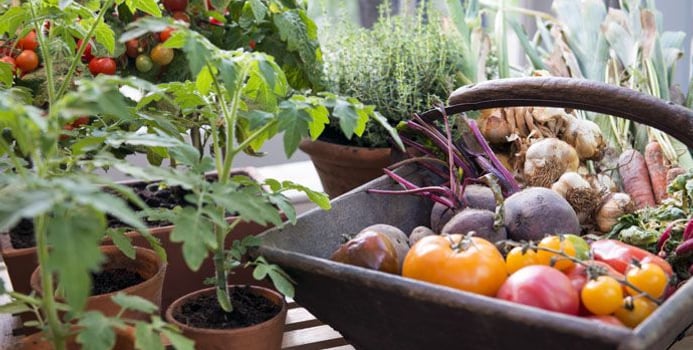Try a New Vegetable or Fruit Each Week
Have you ever had grilled nopales? Banish baby carrots and snack on sliced jicama instead. One of my new favorites is called ground cherries (also called Cape gooseberries). They taste tropical, a bit sweet, a have a flavor that tastes like a combination of pineapples, mangoes, and tomatoes. Ground cherries are small, yellow, edible berries that are encased in a papery husk, much like tomatillos. The texture can be described as something between a grape and a tomato, and they are excellent in both savory and sweet dishes. Pick up a new fruit or veggie each time you visit your grocery store or farmers' market to keep healthy eating fun and tasty.
Select Superb Seasonings
One of the most common mistakes people make when trying to eat healthier is forgetting to amp up the herbs and spices to impart a flavor that is usually provided by copious amounts of fat, sugar, and salt. Be sure to stock up on an assortment of spices and dried herbs. Store them in a cool, dry place away from direct sunlight — your pantry is the perfect location. If the color or smell has faded, it’s time to throw it out and buy new.
Visit Local Restaurant with Healthy Offerings
Just because you are trying to eat healthy doesn’t mean dining out is off-limits. With more people trying to stick to a healthy eating plan, restaurants have taken notice and are offering a larger array of better-for-you dishes. Check out the menu online to have an idea of what to order before you arrive. Don't be afraid to make special requests to lighten up a dish--ask for the sauce on the side, request it be baked or grilled instead of fries, and sub in steamed vegetables for fries or chips. There are free smartphone apps available to help you locate restaurants near you that provide healthy dishes.
Challenge Yourself to Makeover One Unhealthy Dish Each Month
Pizza. French fries. Hot wings. Fettuccine alfredo. What comes to mind when you think of these foods? These are usually high-fat, high-calorie dishes, but they don’t have to be. You can easily tweak the ingredients or preparation method to slash calories and still enjoy your favorites. Makeover your pizza by starting with a cauliflower crust, making your own sauce without tons of sugar, using reduced-fat cheese, loading it up with fibrous veggies, and opting for lean proteins such as grilled chicken, turkey pepperoni, or Canadian bacon. Use an air-fryer to make a lower-calorie version of French fries. Get creative in your kitchen to make simple ingredient swaps that’ll allow you to still indulge without the bulge.
Try Different Cuisines from Around the Globe
Seek out global cuisines that have not been “Americanized” to relish them in their unadulterated form for light, nutritious, tasty meals. Go Greek for a dose of deep-hued, leafy greens, filling beans and lentils, whole grains, colorful fruits, fatty fish, and, of course, heart-healthy olive oil. Vietnamese dishes, which center on vegetables, lean fish, and plenty of fresh herbs, are incredibly healthy. Authentic, traditional Mexican cuisine — based on tomato-based sauces, fresh vegetables, lean seafood, beans, soups, herbs, and spices — looks vastly different from the Americanized version, which is laden with fat from cheeses, sour cream, chips, and fried fare.
Drop Acid...Onto Your Food, That Is
Food needs an acidic component to help round out the flavor and provide balance, brightness, and complexity to a dish. Acids, such as fruity, citrus juices, pungent mustards, and deeply-flavorful vinegars, contribute a huge punch of flavor without many calories. A squeeze of lemon or lime juice (bonus flavor if it’s grilled), a squirt of Dijon mustard, or a drizzle of balsamic vinegar can bring bursts of flavor without the calories or fat found in butter, oil, cheese, or other ingredients typically used to add seasoning.
Experiment with Different Cooking Techniques
Sure, you have probably eaten a pear before, but have you ever had a pear poached in coconut milk seasoned with cinnamon and nutmeg? Most people have had a few radish slices in a salad or slaw before, but they pack so much more enormous flavor when seasoned with olive oil, rosemary, salt, and pepper and roasted in the oven. Slow-roasting tomatoes imparts such robust, deep, smoky taste that you'll wonder why you never cooked them this way before. Roasting — the easiest way to amplify the sweet, earthy tastes of vegetables — yields greater flavor than simply steaming.
Still Enjoy Your Favorite Foods ... Just Less Often
A life without French fries is not a life I want to live! You can still eat your favorite splurge foods, but instead of having them several times each week, truly savor them one or two times a month. Not only will you look forward to them more, but they will also taste better if they are more of a special treat as opposed to a routine part of your diet. You can also split an order of higher-calorie items to savor a few bites without overdoing it on calories.
Salsa Dance
Salsas can add a ton of explosive flavor, vibrant color, and tantalizing texture to otherwise bland dishes. Salsa typically has a negligible 5-20 calories per serving but boasts immense flavor and a little — or a lot — of heat. Try my favorite — salsa verde — on grilled chicken, shrimp, or flank steak, or opt for a chunky pico de gallo salsa rather than ranch dressing for your salads or crudités.
Try Growing Your Own Produce
Heavily-processed foods don’t contain all of the naturally-occurring fiber and antioxidants as whole foods. Not only will gardening encourage you to eat more fruits, vegetables, and herbs, it’ll require some elbow grease in the process. Gardening burns tons of calories and provides you with low-calorie, nutrient-dense ingredients that should make up at least half of your plate — fruits and veggies.
[Image via Shutterstock]



